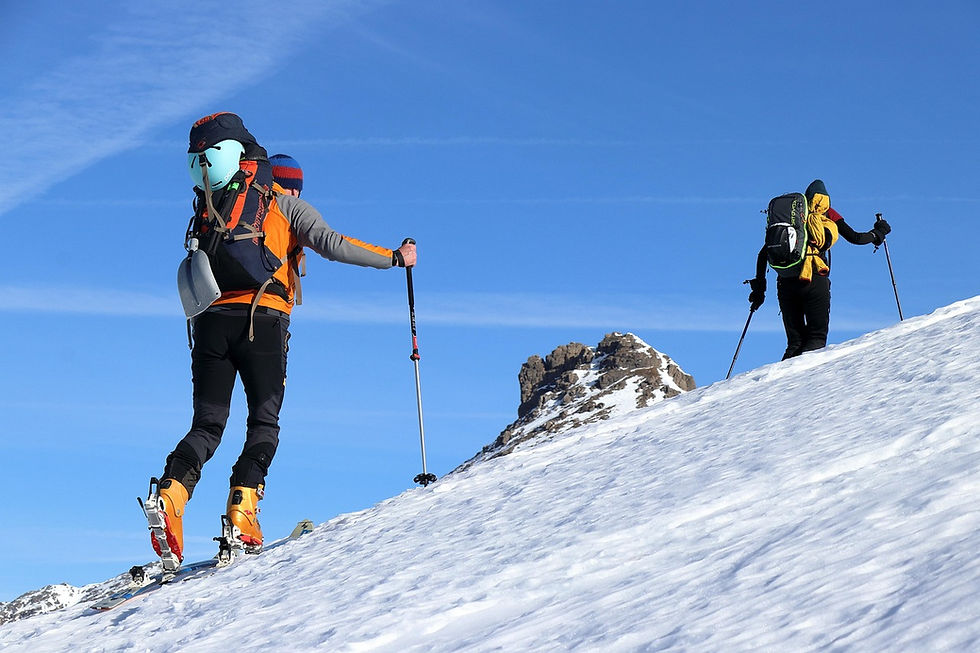Modern Backcountry Skiing: Gear, Safety, and Culture in the 21st Century
- Colton Barry
- Apr 3
- 3 min read
This post is Part 2 of our Backcountry Series on Powder Innovation, where we explore the evolution of gear, culture, and safety in ski touring. If you missed Part 1: The History of Backcountry Skiing, be sure to start there for the full backstory.
The Evolution of Backcountry Skiing: From Niche to Mainstream
In the last 20–25 years, backcountry skiing and splitboarding have evolved from fringe hobbies to fast-growing passions for millions of skiers and snowboarders. With lighter gear, better safety tools, real-time snow data, and booming community support, backcountry skiing is more popular and more advanced than ever.

Gear Innovations That Transformed Touring
Lightweight Skis & Splitboards
Modern backcountry skis and splitboards are designed for both floating in deep snow and powerful descents.
Carbon fiber & lightweight wood cores
Rocker shapes + sidecut = easier turns
Splitboard designs now rival solid boards in performance
High-Performance Touring Boots
Today’s backcountry ski boots combine:
Walk mode + tech fittings for uphill ease
Stiff downhill performance
Ultralight materials like Grilamid or carbon
Examples: Scarpa Maestrale RS, Dynafit Hoji, Atomic Backland
Splitboarders also explore hardboot setups, using AT boots for splitboard touring efficiency.
Tech Bindings & Hybrid Systems
The tech binding revolution is complete:
Lightweight pin bindings dominate
Hybrid bindings (e.g., Salomon Shift, Marker Duke PT) allow resort/downhill flexibility
Frame bindings are now a niche or budget option for shorter trecks
Climbing Skins: Grip Meets Glide
Modern climbing skins are lighter, easier to use, and more specialized:
Nylon = better grip
Mohair = better glide
Blended = best of both worlds
Adhesive glues now stick in freezing temperatures and peel off cleanly. Glueless and silicone-backed skins are gaining popularity.
Avalanche Safety Tech: Smarter, Lighter, Life-Saving
Avalanche survival tools have advanced dramatically:
Avalanche Beacons
Modern digital beacons have 3 antennas, signal direction indicators, and better range
Faster, easier to use than analog beacons
Airbag Packs
Battery-powered airbags (like JetForce) allow multiple deployments
Safer and more travel-friendly than gas canisters
Additional Tools
Avalungs: snow snorkels for breathing under burial
RECCO reflectors in clothing help search teams locate victims
Improved helmets and packs integrate safety features
The Information Revolution: Backcountry in the Digital Age
Before smartphones, backcountry travel relied on word-of-mouth and paper maps.
Today, digital tools include:
onX Backcountry, Gaia GPS, Caltopo = route planning + offline maps
Avalanche.org, local avy centers = real-time avalanche risk
Community forums = trip reports, beta, and route sharing
A Cultural Shift: Growth, Diversity & Responsibility
Pandemic Growth & Community Expansion
In 2020–2021, backcountry use exploded:
2.15M backcountry skiers (+96%)
2.14M splitboarders (+50%)
Trailheads packed at dawn on powder days.

Access, Education, and Mentorship
The backcountry community now offers:
More avalanche courses (AIARE, AAA)
Uphill access at resorts
Expanded hut systems and guided tours
Mentorship movements via social media and local orgs.
A More Inclusive Backcountry
Backcountry skiing is now reaching more people than ever:
Women’s camps, such as Backcountry Babes, BIPOC affinity groups, adaptive ski programs
Representation in films, magazines, and pro sponsorships
Culture shift from exclusive to welcoming and community-driven
What Comes Next?
From carbon skis to 3D dynamic digital maps, backcountry skiing is evolving fast, but the sport's soul remains rooted in adventure, self-reliance, and respect for the mountains.
Next in the Series
Essential Gear for Backcountry Skiing | How to Make Smart Backcountry Gear-Buying Decisions
Haven't read part one? Click The History of Backcountry Skiing
Explore the full Backcountry Series
Further Reading Sources
Click here to find articles if you're interested in learning more!
Author’s Note: This post draws from historical records, interviews, and curated research from leading ski historians and publications. See the “Further Reading” section for full sources.





Comments